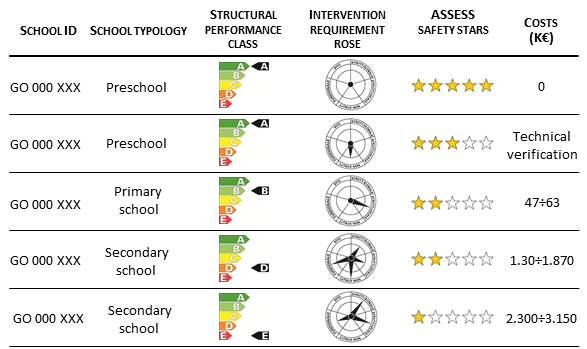ASSESS project: Analysis of the Seismic ScEnarios of the School buildings for a definition of retrofitting priorities for Seismic risk reduction.
UNESCO defined the ASSESS project as “a very good example for decision making process around the world for assessing and implementing measures leading to school safety”, and it asked to prof. S. Grimaz to share the ASSESS experience at Global Platform on Disaster Risk Reduction UNISDR - 2013, in Geneva (link to the presentation).
The ASSESS project (Analysis of the Seismic ScEnarios of the School buildings for a definition of retrofitting priorities for Seismic risk reduction) was a 3-year project started in 2008 as an initiative of the Civil Protection of the Friuli Venezia Giulia Region (Italy) aimed at reaching a global knowledge about the seismic risk of schools in the region, so as to highlight the weaknesses and provide tools for decision support for emergency management and activation of the consequent actions for risk mitigation.
ASSESS is the natural continuation of projects funded by the Friuli Venezia Giulia Region from 1976 (the year of the terrible earthquake) and developed jointly by OGS (National Institute of Oceanography and experimental Geophysics) and the universities of Udine and Trieste.
ASSESS activities focused on a general cognitive assessment for all the schools in the region, in parallel and in support of the ordinary activities provided for by the Ordinance 3274/03 concerning the obligation to seismic verification of strategic and important buildings by the owner institutions.

The development of ASSESS has followed a comprehensive, interdisciplinary, progressive, and finalized approach through an investigative methodology structured on three levels: the first one (desk approach), based on existing documents, interested all the 1,022 schools located in Friuli Venezia Giulia; the second (expeditious approach), based on field fast inspections, interested a sample, suitably selected, of a hundred buildings; the third (detail approach) was a calibration of the analysis methods developed and verification of the results obtained in the previous levels on a sample of about a dozen buildings.
The seismic performance of a building is evaluated using a simplified calculation methods. In particular, the seismic performance is defined by the ratio between the strength capacity and the reference acceleration at the site. Five classes of structural performance have been defined considering the design acceleration, as defined by specific regulations, using graphic symbols similar to those used to define the energy efficiency classes.

The structural performance is not the only indicator when the overall problem of seismic safety is under investigation. It is necessary, indeed, to judge all aspects that can contribute to causing casualties or injuries.

Five main bearers of potential problems have been identified in the ASSESS project, namely: the problems of the site, the global and the local structural, non-structural deficiencies, and, finally, the functional ones. The potential deficiencies for each investigated aspect are identified and classified into 3 degrees of severity and are represented in a graph summary called "rose of intervention".
The summary judgment on the conditions of global seismic safety is finally rated in terms of " safety stars." The basic concept of the "safety stars " is the same one used in other fields, where a judgment of quality / overall performance is required (e.g., the quality of the hotels, the quality of cars). After several evaluations, every single star is assigned only if the building meets certain requirements.

The synthetic data for the site and building characterization are reported in lists like the one shown below, together with an indication of the range of estimated costs for the proposed interventions.

These results, in addition of providing overall frameworks of territorial extension, allow us to formulate priority lists for intervention distinguished according to the different criteria on which the interventions should be based (source of funding, area of intervention, risk level, type of intervention , etc.) and to arrive at a rough estimate of the financial resources necessary for their implementation.
The study has highlighted the importance of creating priority lists of intervention for a better and more rational allocation of economic resources, according to criteria that take into account different aspects (characteristics of the sites, the vulnerability of the structures, possible strategic role of buildings in terms of civil protection, etc.).

Moreover, the study has pinpointed how the creation of priority lists based only on the structural vulnerability can lead to gross errors and improper use of resources (investment for the structural retrofitting of buildings located in potentially unstable areas under the seismic or geological profile of the site). In this regard it should be noted that this error can potentially be committed even if we proceed in agreement with the more detailed structural seismic monitoring requested by OPCM 3274/03.
The methodology developed and adopted in the framework of the ASSESS project is a useful tool for decision support in terms of civil protection, for planning seismic risk reduction, extensible, however, also to other types of strategic or important buildings.
Start - end project : 2008 - 2011.

